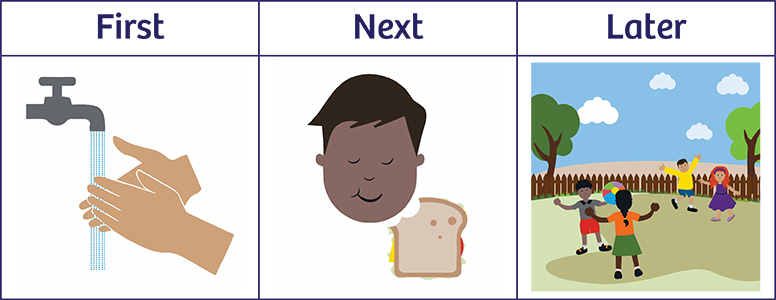
Many children start their day with a sense of excitement and anticipation. Some, however, experience a sense of anxiety and dread. Presenting children with a schedule of the day’s events can be a positive strategy to adopt in order to manage all of the moods and attitudes you may encounter – whether in the classroom or early learning environment, at home with a child or in settings for sports and other activities.
Presenting information about a child’s routine in an attractive, visual format gives the child information about what to expect. It also gives them the opportunity to set their attitude for the day by identifying events they can look forward to, be excited about and motivated for. Knowing what’s ahead can alleviate the anxiety some students experience in relation to aspects of their activities, the curriculum at school or their workload – for example, knowing that they can spend time in the afternoon working on their project can help clear their head during earlier sessions.
Different age groups may require different levels of detail in a schedule – ‘Maths’ may be enough for older students, ‘Numbers and counting’ may be a necessary detail to include for early learners. In the current environment of flexible learning spaces, teachers may only be responsible for their own learning group and the schedule for their class may not correspond with the work students are doing with other teachers. Knowing they have Maths though can be enough to trigger reminders about how they should be prepared for the session.
Adding detail about time or including clocks on a schedule can support children to understand how much time has been allocated to a task or topic and when they can expect it to end. This can relieve pressure for children who experience anxiety and also children on the autism spectrum who can benefit from knowing how much time remains for the work they are doing and prepare themselves for the transition to a new topic or task. Using clocks can also help children recognise the practical purpose of telling the time and support them with their acquisition of relevant concepts.
Using visuals to support items on a schedule can be a helpful suggestion for quick reference or from a distance and can support students who have a preference for visual learning. Using images and icons can also support early or new language learners who are yet to master reading skills. Providing images of the tools, materials or equipment they might require alongside items on the schedule can also help children be organised for each activity, supporting them in the development of important self-organisation skills that lead them towards independence.
In the classroom, having a visual schedule not only supports the students but can also help the adults. Presenting the day’s activities makes teachers accountable for what needs to happen in their classroom on a particular day. Preparing and presenting a schedule can ensure the teacher is prepared for the diverse range of needs presented by the students and the curriculum. Teacher aides can also benefit by knowing what to expect and helping them prepare for the work they need to do with the students in their care.
